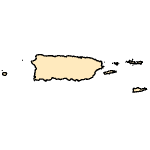Labeotropheus fuelleborni
(blue mbuna)
Fishes
Exotic |
|
Common name: blue mbuna
Taxonomy: available through
www.itis.gov
Identification: Labeotropheus fuelleborni is a haplochromine cichlid with an enlarged snout of fibrous connective tissue that hangs over a wide ventrally situated mouth with curved chisel-like teeth (Fryer 1959, Pauers et al. 2017). This species has a high level of color polymorphism. Male coloration develops gradually until maturity when the color changes to brilliant blue at times with golden yellow on the flanks (Fryer and Iles 1972, Pauers 2011). The anal fin on the male has 2 to 4 bright orange ‘egg dummy’ spots along the posterior margin (Fryer 1959). The females have at least two color morphs, a normal coloration (N) of dull blue-grey that is lighter ventrally with or without 8 black, brown, or blue-grey vertical bars along the body or an orange-blotch (OB) variation. In the OB variation, the body is marked by blotches of black, orange, or white with some individual females solid yellow (Fryer and Iles 1972, Ribbink et al. 1983).
Size: Up to 12 cm total length with females slightly smaller than males (Loiselle 2000)
Native Range: Labeotropheus fuelleborni is endemic to Lake Malawi, Africa (Pauers 2017).



|

Alaska |

Hawaii |

Puerto Rico &
Virgin Islands |

Guam Saipan |
Hydrologic Unit Codes (HUCs) Explained
Interactive maps: Point Distribution Maps
Nonindigenous Occurrences:
Table 1. States with nonindigenous occurrences, the earliest and latest observations in each state, and the tally and names of HUCs with observations†. Names and dates are hyperlinked to their relevant specimen records. The list of references for all nonindigenous occurrences of Labeotropheus fuelleborni are found here.
Table last updated 12/19/2025
† Populations may not be currently present.
Ecology: Labeotropheus fuelleborni is a rock-dwelling cichlid found primarily in shallow (1-5 m) water, rarely deeper than 8 m (Ribbink et al. 1983). They use their specialized chisel-like teeth to scrape aufwuchs, a mix of algae, microbes, and detritus, that encrusts on the surface of the rocks (Ribbink 1990). This species is territorial and typically feeds alone or in small groups, but occasionally will join a feeding school of other species to raid nearby algae patches (Marsh and Ribbink 1986). They are also opportunistic feeders consuming plankton, insects, eggs, and fry (Fryer 1959). Labeotropheus fuelleborni is a mouth brooder with the female brooding the eggs in her mouth for 22 to 30 days, after which the fry disperse in the rock crevices to avoid predation (Fryer and Iles 1972, Ribbink et al. 1983).
Means of Introduction: aquarium release or stocked
Status: Eradicated from Pinecrest Gardens in 2017 (Schofield et al. 2019).
Impact of Introduction: The impacts of this species are currently unknown, as no studies have been done to determine how it has affected ecosystems in the invaded range. The absence of data does not equate to lack of effects. It does, however, mean that research is required to evaluate effects before conclusions can be made.
References: (click for full references)
Fryer, F. 1959. The trophic interrelationships and ecology of some littoral communities of Lake Nyasa with especial reference to the fishes, and a discussion of the evolution of a group of rock-frequenting Cichlidae. Proceedings of the Zoological Society of London 132:153-281.
Fryer, G., and T.D. Iles. 1972. The cichlid fishes of the great lakes of Africa. Oliver & Boyd, Edinburgh, United Kingdom.
Loiselle, P. 2000. An Interpret guide to African cichlids: A splendid introduction to this diverse and attractive group of tropical freshwater fishes. Interpret Ltd, Surrey, United Kingdom.
Marsh, A.C., and A.J. Ribbink. 1986. Feeding schools among Lake Malawi cichlid fishes. Environmental Biology of Fishes 15:75-79.
Pauers, M.J. 2011. One fish, two fish, red fish, blue fish: Geography, ecology, sympatry, and male coloration in the Lake Malawi cichlid genus Labeotropheus (Perciformes: Cichlidae). International Journal of Evolutionary Biology [article ID 575469].
Pauers, M.J. 2017. A new species of Labeotropheus (Perciformes: Cichlidae) from southern Lake Malawi, Africa. Copeia 105:399-414.
Ribbink, A.J., A.C. Marsh, B.A. Marsh, and B.J. Sharp. 1983. The zoogeography, ecology and taxonomy of the genus Labeotropheus Ahl, 1927, of Lake Malawi (Pisces: Cichlidae). Zoological Journal of the Linnean Society 79:223-243.
Schofield, P.J., H. Jelks, and K.B. Gestring. 2019. Eradication of two non-native cichlid fishes in Miami, Florida (USA). Management of Biological Invasions 10:296-310.
Author:
Brown, M.E.
Revision Date: 9/20/2023
Peer Review Date: 1/9/2023
Citation Information:
Brown, M.E., 2025, Labeotropheus fuelleborni Ahl, 1926: U.S. Geological Survey, Nonindigenous Aquatic Species Database, Gainesville, FL, https://nas.er.usgs.gov/queries/FactSheet.aspx?speciesID=3017, Revision Date: 9/20/2023, Peer Review Date: 1/9/2023, Access Date: 12/19/2025
This information is preliminary or provisional and is subject to revision. It is being provided to meet the need for timely best science. The information has not received final approval by the U.S. Geological Survey (USGS) and is provided on the condition that neither the USGS nor the U.S. Government shall be held liable for any damages resulting from the authorized or unauthorized use of the information.